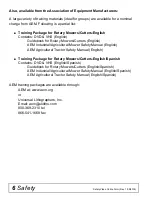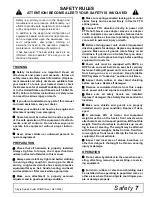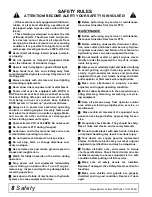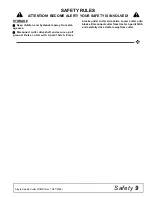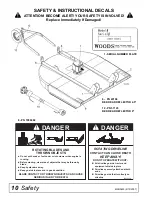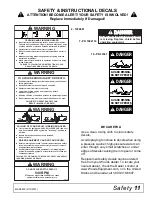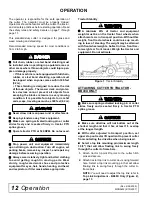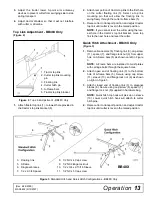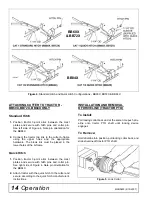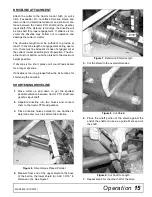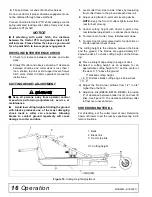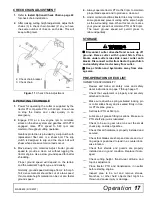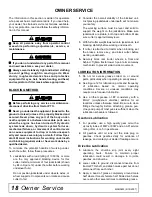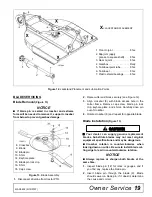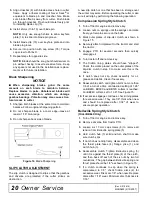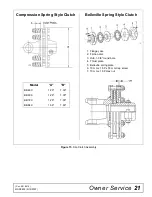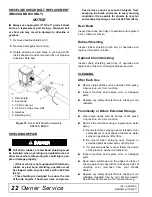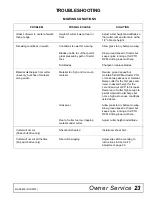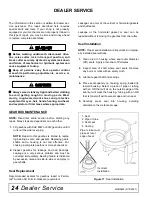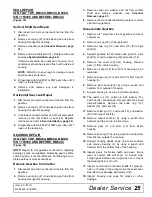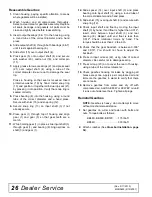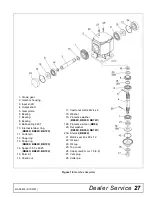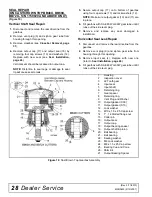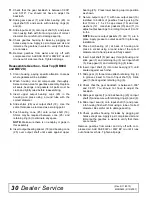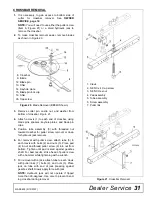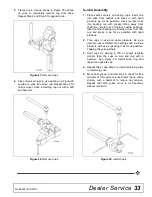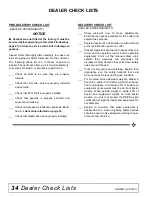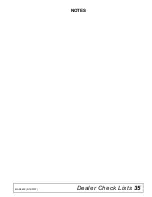
20
Owner Service
MAN0632 (5/15/2007)
3.
Align crossbar (8) with blade access hole in cutter
frame. Apply a liberal coating of Never Seez
®
or
equivalent to blade pin and crossbar hole. Make
sure blade offset is away from cutter. Push blade
pin through crossbar. Pin should rotate freely prior
to installing blade clip (15).
4.
Install shims (13 & 16) over blade pin.
NOTE:
Only use enough shims to allow keyhole
plate (14) to slide into blade pin groove.
5.
Install blade clip (15) over keyhole plate and into
blade pin groove.
6.
Secure into position with cap screw (35). Torque
cap screw to 85 lbs-ft.
7.
Repeat steps for opposite side.
NOTE:
Blade should be snug but should swivel on
pin without having to exert excessive force. Keep
any spacers not used in the installation as replace
-
ments or for future installation.
Blade Sharpening
NOTICE
■
When sharpening blades, grind the same
amount on each blade to maintain balance.
Replace blades in pairs. Unbalanced blades will
cause excessive vibration, which can damage
gearbox bearings. Vibration may also cause struc
-
tural cracks to cutter.
1.
Sharpen both blades at the same time to maintain
balance. Follow original sharpening pattern.
2.
Do not sharpen blade to a razor edge—leave at
least a 1/16" blunt edge.
3.
Do not sharpen back side of blade.
Figure 14
. Blade Sharpening
SLIP CLUTCH ADJUSTMENT
The slip clutch is designed to slip so that the gearbox
and driveline are protected if the cutter strikes an
obstruction.
A new slip clutch or one that has been in storage over
the winter may seize. Before operating the cutter, make
sure it will slip by performing the following operation:
Compression Spring Style Clutch
1.
Turn off tractor engine and remove key.
2.
Loosen nuts on springs until the springs can rotate
freely, yet remain secure on the bolts.
3.
Mark outer plates of slip-disc clutch as shown in
Figure 15.
4.
Securely attach implement to the tractor and start
the tractor.
5.
Engage PTO for several seconds then quickly
disengage it.
6.
Turn tractor off and remove key.
7.
The friction lining plates should have "slipped".
Check the marks placed on the outer plates of the
slip-disc clutch in step 3 to make sure this is the
case.
8.
If clutch does not slip, check assembly for oil,
grease and debris. Clean if necessary.
9.
Reassemble clutch and tighten bolts no more than
1/8 of a turn at a time until desired setting of 1.26"
on BB48X, BB60X and BB72X cutters is reached.
For BB84X cutters, set to 1.36". See Figure 15.
10.
If excessive slippage continues, check lining plates
for excessive wear. They are 1/8" thick when new
and should be replaced after 1/32" of wear to
ensure proper operation.
Belleville Spring Style Clutch
(Older BB84X Only)
1.
Turn off tractor engine and remove key.
2.
Remove driveline from tractor PTO.
3.
Loosen six 10 mm cap screws (6) to remove all
tension from Belleville spring plate (5).
4.
Hold clutch hub (3) solid and turn shaft to make
sure clutch slips.
5.
If clutch does not slip freely, disassemble and clean
the thrust plate faces (4), flange yoke (1), and
clutch hub (3).
6.
Reassemble clutch. Tighten Belleville spring (5)
until it is against the thrust plate (4) of the clutch,
and then back off each of the six nuts by two full
revolutions. The gap between Belleville spring and
thrust plate should be 1/8" as shown in Figure 15.
7.
If a clutch continues to slip when the spring is
compressed to 1/8", check friction discs (2) for
excessive wear. Discs are 1/8" when new. Replace
discs after 1/16" wear. Minimum disc thickness is
1/16".
(Rev. 5/21/2018)

